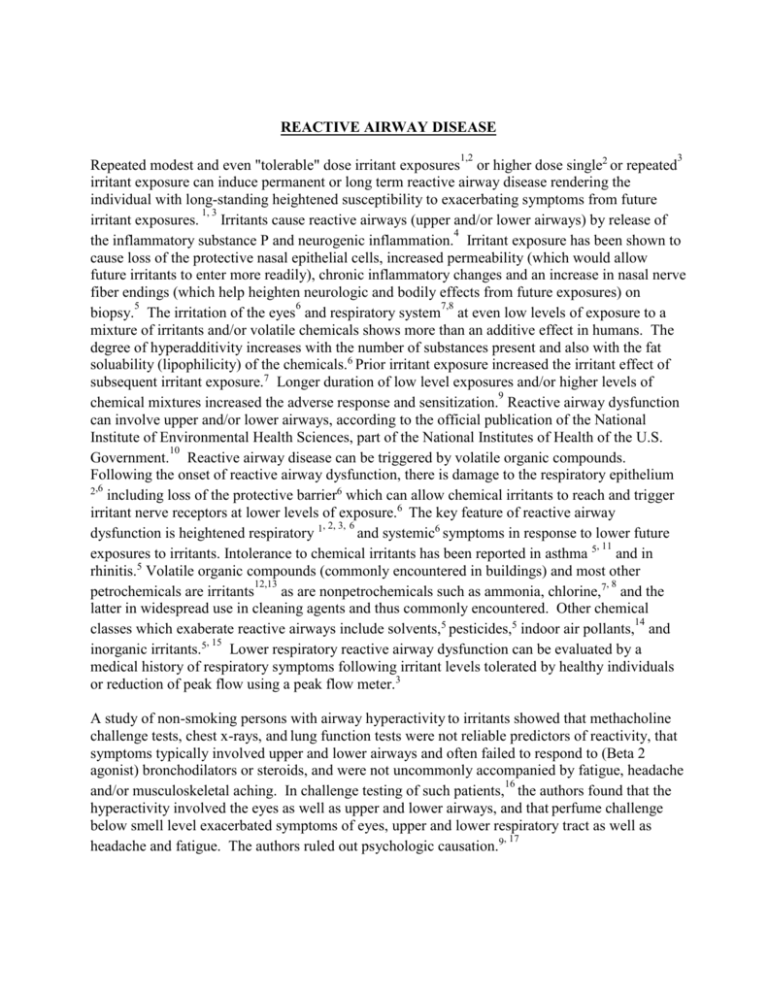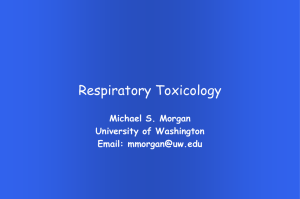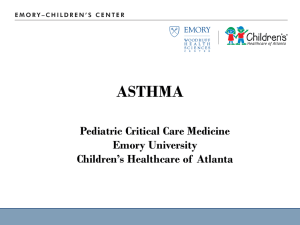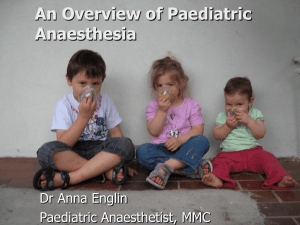Reactive Airway Disease
advertisement

REACTIVE AIRWAY DISEASE 1,2 3 Repeated modest and even "tolerable" dose irritant exposures or higher dose single2 or repeated irritant exposure can induce permanent or long term reactive airway disease rendering the individual with long-standing heightened susceptibility to exacerbating symptoms from future 1, 3 irritant exposures. Irritants cause reactive airways (upper and/or lower airways) by release of 4 the inflammatory substance P and neurogenic inflammation. Irritant exposure has been shown to cause loss of the protective nasal epithelial cells, increased permeability (which would allow future irritants to enter more readily), chronic inflammatory changes and an increase in nasal nerve fiber endings (which help heighten neurologic and bodily effects from future exposures) on 5 6 7,8 biopsy. The irritation of the eyes and respiratory system at even low levels of exposure to a mixture of irritants and/or volatile chemicals shows more than an additive effect in humans. The degree of hyperadditivity increases with the number of substances present and also with the fat soluability (lipophilicity) of the chemicals.6 Prior irritant exposure increased the irritant effect of subsequent irritant exposure.7 Longer duration of low level exposures and/or higher levels of 9 chemical mixtures increased the adverse response and sensitization. Reactive airway dysfunction can involve upper and/or lower airways, according to the official publication of the National Institute of Environmental Health Sciences, part of the National Institutes of Health of the U.S. 10 Government. Reactive airway disease can be triggered by volatile organic compounds. Following the onset of reactive airway dysfunction, there is damage to the respiratory epithelium 2,6 including loss of the protective barrier6 which can allow chemical irritants to reach and trigger irritant nerve receptors at lower levels of exposure.6 The key feature of reactive airway , 2, 3, 6 dysfunction is heightened respiratory 1 and systemic6 symptoms in response to lower future , 11 exposures to irritants. Intolerance to chemical irritants has been reported in asthma 5 and in rhinitis.5 Volatile organic compounds (commonly encountered in buildings) and most other 12,13 ,8 petrochemicals are irritants as are nonpetrochemicals such as ammonia, chlorine,7 and the latter in widespread use in cleaning agents and thus commonly encountered. Other chemical 14 classes which exaberate reactive airways include solvents,5 pesticides,5 indoor air pollants, and , 15 inorganic irritants.5 Lower respiratory reactive airway dysfunction can be evaluated by a medical history of respiratory symptoms following irritant levels tolerated by healthy individuals or reduction of peak flow using a peak flow meter.3 A study of non-smoking persons with airway hyperactivity to irritants showed that methacholine challenge tests, chest x-rays, and lung function tests were not reliable predictors of reactivity, that symptoms typically involved upper and lower airways and often failed to respond to (Beta 2 agonist) bronchodilators or steroids, and were not uncommonly accompanied by fatigue, headache 16 and/or musculoskeletal aching. In challenge testing of such patients, the authors found that the hyperactivity involved the eyes as well as upper and lower airways, and that perfume challenge below smell level exacerbated symptoms of eyes, upper and lower respiratory tract as well as , 17 headache and fatigue. The authors ruled out psychologic causation.9 Reactive Airway Disease Page 2 of 2 A community based epidemiologic study confirms that persons with a diagnosis of asthma also have a significantly higher degree of illness exacerbation from irritants such as new carpets, 18 scented products and cleaning agents compared to nonasthmatics. Persons with a diagnosis of hay fever experienced frequent illness exacerbation from irritants such as pesticides and vehicle exhaust. Both groups experienced significant exacerbation from irritants such as drying paint and passive smoke.12 The authors felt that these responses indicated significantly increased hyperresponsiveness to irritants (reactive airway disease) involving lower (asthmatics) and upper airways.12 Once occupational asthma has been induced, the majority of affected persons continue to demonstrate asthma symptoms and airway hyperreactivity/hyperresponsiveness years after the 19 initial causal exposure has ceased. This leaves them with a long-standing medical condition involving symptoms triggered by a wide variety of irritants.13 1 H.M. Kipen, et al., "Asthma experience in an occupational medicine clinic. Low dose reactive airway dysfunction syndrome", J. Occup. Med. 36:1133-1137, 1994. 2 S.M. Brooks, et al., "Reactive airway dysfunction syndrome", J. Occup. Med. 27, 473-476, 1985. 3 S.M. Tarbo and I. Broder, "Irritant-induced occupational asthma", Chest 96:297-300, 1989. 4 WJ Meggs, “RADS and RUDS-The toxic induction of asthma and rhinitis”, Clinic Toxic 32(5): 487-501, 1994. 5 WJ Meggs et al., “Nasal pathology and ultrastructure in patients with chronic airway inflammation (RADS and RUDS) following an irritant exposure”, Clinical Toxicology 34(4): 383-396, 1996. 6 A Hempel-Jorgensen et al., “Sensory eye irritation in humans exposed to mixtures of volatile organic compounds”, Archiv Environ Health 54: 416-424, 1999. 7 HK Hudnell etal,. “Exposure of humans to volatile organic mixture. II. sensory”, Archiv Environ Health 47:31-38, 1992. 8 JE Cometto-Muniz et al., “Agonist sensory effects of airborne chemicals in mixtures: odor, nasal prengency and eye irritation”, Percept Psychophysiol 59: 665-674, 1997. 9 HK Hudnell et al., “Time course of odor and irritation effects in humans exposed to a mixture of 22 volatile organic compounds”, Proc Indoor Air ‘93 1: 567-572,1993. 10 W.J. Meggs, "Neurogenic inflammation and sensitivity to environmental chemicals", Env. Health Perspectives, 101:234-237, 1993. 11 C Shim, MH Williams Jr., “Effect of odors in asthma”, Am J Med 80: 18-22, 1986. 12 N.H. Proctor and J.P. Hughes, Editors, Chemical Hazards of the Workplace, J.B. Lippincott, Philadelphia, PA. 13 R.E. Lenga, Editor, The Sigma-Aldrich Library of Chemical Safety Data, pp. 1-3636, Sigma Aldrich Corporation, Milwaukee, WI. 14 WJ Meggs, “Health effects of indoor air pollution”, NC. Med Journal53(7): 354-358, 1992. 15 KH Kilburn, Chemical Brain Injury, New York: John Wiley, 1998. 16 E Millqvist et al., “Sensory hyperreactivity-a possible mechanism underlying cough and esthma-like symptoms”, Allergy 53: 1208-1212, 1998. 17 E Millqvist et al., “Provocations with perfume in the eyes induce airway symptoms in patients with sensory hyperreactivity”, Allergy 54: 495-499, 1999. 18 C. Baldwin et al., “Odor sensitivity and respiratory complaint profiles in a community-based sample with asthma, hay fever, and chemical odor intolerance”, Toxicology and Industrial Health 15: 403-409, 1999. 19 L. Perfetti et al., “Changes in IgE-mediated allergy to ubiquitous inhalants after removal from or diminution of exposure to the agent causing occupational asthma”, Clinical and Experimental Allergy 28: 66-73, 1998.









